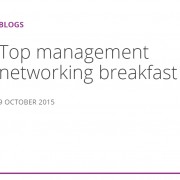CEO Statement: Shaping the future of intelligent networking
by Jay Jayasimha, CEO, Cataleya
Cataleya has had an amazing start but it is just the beginning of our journey. In less than two years, we have already deployed our technology in Asia, Africa, Europe and the US. We also have trials happening all over the world from Tier 1 carriers to local and niche service providers.
We have built a great momentum in 2015 and I am proud of the impact we have since made in the market. I can see another wave of key deployments hitting the news in 2016 and what is more delighting is that we are hearing positive feedback from customers and they are asking us to help them solve new challenges.
Our goal when we developed the next-generation session border controller (SBC) Orchid One was not to just disrupt the SBC market, it was to find solutions for the biggest challenges faced by service providers. We could see that the migration from TDM to IP could not have happen without guaranteed quality of service (QoS) and experience (QoE) on IP networks. Service providers need to increase visibility into their networks, otherwise their IP services will remain ‘best effort’. We accepted this challenge and built an intelligent networking technology that enables service providers to gain full end-to-end visibility into network performance with real-time network data and analytics.
Over the last 12 to 18 months, we have established our role in the transition from TDM to IP and now I believe we can really explore where we can take our technology and find new benefits for customers. Orchid One is proving its value in the migration from TDM to IP networks but that is just one of the many ways it can support the success of our customers.
With end-to-end visibility into the network performance, we are seeing new ways to use this data and new possibilities for our customers. We did not develop Orchid One to be deployed in networks and stand still. It was purpose-built to grow and evolve as customers tackle increasingly sophisticated challenges as their business grows.
The transition from TDM to IP is a major driver for our customers adopting Orchid One but I want them to know that it can offer so much more than just guaranteed QoS and QoE end-to-end. It is a platform for using data and analytics to support the overall success of our customers’ businesses.
Accelerating Voice over LTE (VoLTE) Adoption
By the end of 2015, 428 LTE networks will have been rolled out globally. Mobile network operators (MNO) have made the move to 4G in their local networks and we see an opportunity in supporting their transition to Voice over LTE globally. MNOs can benefit from consolidating their voice services into a single network if they can guarantee quality.
So far, many operators have been operating 2G/3G and 4G networks in parallel to ensure that their voice services are not disrupted. That is costly, complex and inefficient. We are solving this challenge with guaranteed QoS and QoE on 4G. Similarly, we can assist MNOs’ adoption of LTE by supporting the IPX networks that interconnect them with other operators.
I see this as the next step in the development of LTE. In 2015, we saw more LTE deployments and now MNOs are in a position where they can refine their approach while effectively interconnecting the LTE islands that have emerged. We are playing a major role in that.
The Fight Against Voice Fraud
The visibility that we have into networks and the data that we capture can be used in the fight against voice fraud. While we have had success in guaranteeing network performance, we have also seen an opportunity in using the same network data to identify and mitigate voice fraud. This is not just a fringe benefit. It is a powerful tool in the fight against fraud and protecting a service provider’s profitability.
We looked at the network data we were collecting and saw its potential in fraud prevention. When there is a deeper level of visibility and intelligence in the network, service providers can proactively identify network threats based on real-time analysis of network behaviours. This is supported with machine learning as well as deep voice analysis.
We are recognising historic fraud patterns, real-time network behaviours as well as call analysis so that our customers can be alerted earliest possible and prevent fraud losses. These capabilities are fully integrated into Orchid One leveraging its data and analytics to protect service provider profits. In this way, Orchid One is enabling performance and profitability for customers.
Voice over WiFi (VoWiFi)
I believe VoWiFi will be one of the most influential technologies of 2016. As mobile operators struggle to compete with OTT players, they need to a new weapon. VoWiFi can win subscribers back from OTT services and increase customer loyalty and overall profitability.
VoWiFi is a VoIP based technology that enables end user calls to seamlessly switch between the traditional mobile network and WiFi. So far, only 14 mobile operators have launched VoWiFi in nine different countries, according to GSMA.
The challenge is that globally IP networking remains inconsistent and reliant on a ‘best effort’ model. We are enabling the seamless delivery of IP-based voice services on WiFi with guaranteed QoS and QoE and changing what is possible for mobile operators. Orchid One can support the switching between networks and simplify MNOs’ move into VoWifi.
Exploring New Ways to Use Analytics
All of these areas show the potential of our technology to shape and enable new services. We continue to capture network data and analytics and will find new ways to put them to work for customers. As we explore new opportunities, we are seeing that Orchid One can be a powerful tool with a range of applications in our customers’ businesses.
VoLTE and VoWiFi are ways for service providers to increase their profitability while fighting voice fraud helps to protect these profits. The best thing is that the era of Big Data is really in its infancy and I can see opportunities for applying it to all kinds of service provider challenges.
I think that is what I am most excited about for 2016. We are capturing critical data and have the opportunity to use it to open doors for many more innovations. As our customers’ challenges evolve, we have new opportunities to innovate and offer them solutions that enable them to do more for their customers and deliver the best possible services.













